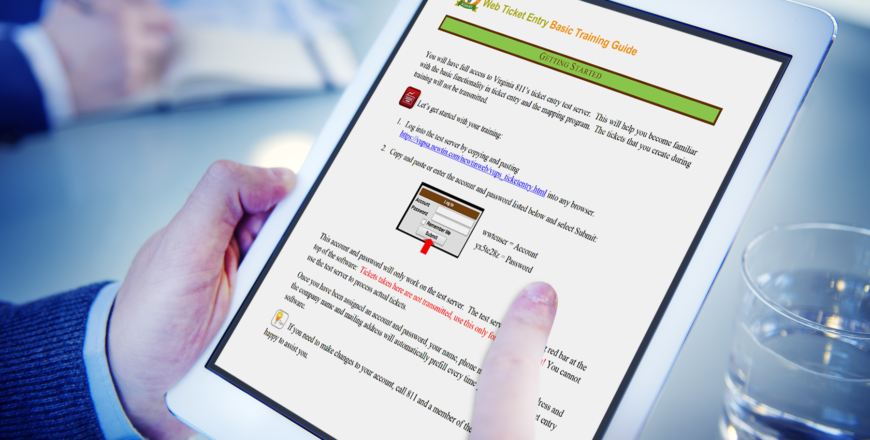Web Ticket Entry: Self-Guided Course

Ticket Entry Overview
The overview will provide a brief description of each section of the ticket entry software.
At the conclusion of training, you will understand that the purpose for a ticket is to protect life and property and that the utility operators who may have underground facilities in the area where you plan to dig will be notified on each ticket you process. You will also learn that the ticket entry software is designed to meet the expectations set forth in the Virginia Underground Utility Damage Prevention Act.
Location Information
The information entered in the Location Information section of the ticket entry screen describes the specific location of where the excavation will take place.
At the conclusion of training you will understand how to select the type of work being done and how to enter the name of the person or business for whom the work is being done. You will learn how to enter the County or City and the street address where the work is taking place. You will also learn the benefit of entering the nearest intersecting street as a cross street and when to answer yes or no to the boring, blasting and white paint questions.
Excavation Area
Entering the description of excavation correctly is essential to processing an accurate ticket.
At the conclusion of the training you will understand that the extent of the proposed excavation shall be a work area that can be completed within fifteen working days and that the area covered shall not exceed one mile. You will learn the difference between linear and non-linear excavation and how to describe where the work is taking place by describing the beginning and ending points, the direction of the excavation and how far out on either side the excavation will take place as well as when to use boundaries. Additional information can be added to the Excavation Area field to include another contact person, driving directions, information about locked gates or unrestrained animals or how to gain access to the property. You will also learn that the utility line locators may need access to the utility meters in the rear of the property, even if the work is only taking place in the front because they may need to hook their locating equipment up to the meter.
Basic Mapping Tools
The mapping software (QuickMap) uses the information entered in the Location Information section of the ticket entry screen to identify the area of proposed excavation on the map.
At the conclusion of training, you will know how to use the basic mapping tools and how their use helps to ensure the accuracy of a ticket and enable you to draw the Notification Polygon in the correct location. You will also learn that comparing the Notification Polygon to the description of excavation to make sure that they match helps ensure the accuracy of the ticket.
Accuracy and Safety – Releasing the Ticket
To ensure everyone’s safety, it is critical that you compare the Notification Polygon to the description of excavation to ensure that the polygon completely covers the area described in the Excavation Area field.
At the conclusion of training, you will know how to compare the description of excavation to the notification polygon to ensure that the Notification Polygon covers the entire area of proposed excavation. You will also understand How to read the Notification Dates section of the ticket entry screen and that the purpose for the Notification Polygon is to identify which underground utilities need to respond to the ticket. You will also understand how to release the ticket and receive the ticket number.



